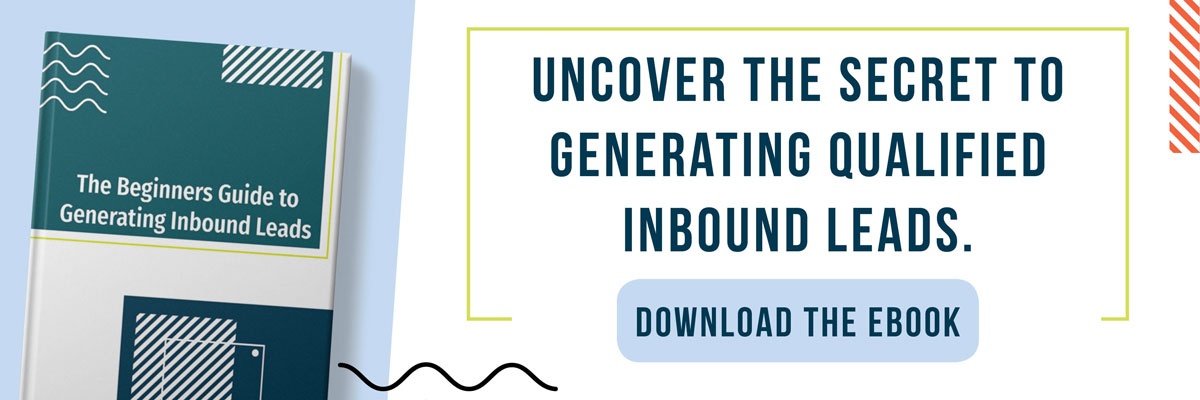As valuable and effective as inbound marketing is, it’s not without its challenges. But as the classic phrase goes, “nothing worth having comes easy.” So, if you want to learn how to overcome marketing challenges, we want to help. Here are three of the most common marketing problems we’ve encountered, how to deal with them, and why marketing success is something worth being patient for.
Inbound marketing is the dominant force in the industry for a reason: it works. Instead of relying on the outbound strategies of old, inbound marketing strategies are built around the customer and their needs. We no longer want to spend our time pursuing leads; we want leads to come to us when they’re good and ready.
As of 2017, almost 80% of marketers had embraced the inbound marketing methodology as the backbone of their strategy. It’s likely that number has only grown since, too. If the inbound marketing tools are used by so many, then they must be foolproof, right?
While a one-size-fits-all approach to marketing success would be nice, not even inbound marketing can promise that. Instead, what it can promise is a path toward success. But that path isn’t always as easy as we’d like it to be, and even the most prepared teams are going to encounter some marketing challenges along the way. When that time comes, however, you’ll want to be prepared, which is what we’re here to help with.
With the points below, we’re going to be examining three of the most common marketing problems and challenges we’ve faced, and seen others face, and propose solutions to each one. This isn’t an all-inclusive list, and the solutions listed may not work for every conceivable situation. Still, when it comes to dealing with (or avoiding) the marketing challenges you’re facing, this is an excellent place to get started.
Challenge #1: A Disengaged Target Audience
Having a solid marketing strategy is essential, but if your audience for that strategy isn’t responding to it, then you’ve got a problem. But how do you define what the problem is? Or more importantly, how do you fix it?
A disengaged target audience can be one of the most frustrating inbound marketing challenges you encounter. Maybe you’ve invested in a documented content strategy (like 65% of the most successful marketers have), but your lead generation still isn’t there. What’s the hold-up?
To find the answer, let’s start with some definitions.
According to Gallup, there are three distinct, primary groups of consumers out there: fully engaged, indifferent, and actively disengaged. Based on that terminology alone, it’s probably safe to assume that you want your audience to fall into that first category. But what if they’re not? What if your target audience, or what you thought was your target audience, are indifferent or even actively disengaged with your brand?
Solution: Buyer Persona Development
The answer to this problem is all about buyer persona development. If your audience isn’t responding to your marketing material, then it’s possible you’re either:
- Marketing to the wrong people
- Marketing to the right people at the wrong time
- Using the wrong kind of marketing materials
To make sure you don’t encounter this marketing challenge any longer than you have to, you’re going to want to invest in developing some detailed buyer personas. After all, 77% of the most successful B2B marketers in the industry use personas for their marketing purposes, so it’s clearly not some passing fad.
If you’re struggling to develop accurate buyer personas for your company, or need a refresher on how buyer persona development looks, here are some questions you should start with:
- How does your ideal customer interact with a vendor?
- Who do you not want to do business with (these are your exclusionary, or “negative,” buyer personas)?
- What kind of challenges do your customers encounter (ideally, challenges you can help resolve)?
- What does your ideal customer care about?
- What kinds of responsibilities do your ideal customers have? How can you help them with those responsibilities?
Once you ask (and then answer) these questions, you’ll be well on your way toward a buyer persona that you can actively (and correctly) market yourself toward.
However, you shouldn’t stop there. Having a robust set of buyer personas is crucial, but it’s perhaps just as essential that you set up those personas in your HubSpot portal. This will allow you to target a specific persona with your marketing materials, categorize your contacts by persona, and more!
Challenge #2: Leads Aren’t Converting, Sales Aren’t Closing
No matter how solid your inbound marketing strategy is, some leads (and sales, for that matter) are just stubborn. So what can you do? How can you work with a lead in a way that will encourage them to convert into a customer without inadvertently pushing them away?
Any lead you encounter has done their fair share of research. As such, they’ve likely compared your services to the services of your competitors. “It’s like a first date,” Entrepreneur says. And like any first date, you want to make a good impression. “How do you make a good impression? With speed, abundant information and follow-up that demonstrates transparency to build trust.”
Solution: Prioritize Lead Nurturing
Ultimately, any lead that enters your sales funnel won’t convert into a customer if they’re not nurtured. Not only do 47% of buyers view “three to five pieces of content before engaging with a sales rep,” but businesses “who nurture leads make 50% more sales at a cost 33% less than non-nurtured prospects.”
If you want your leads to convert, you have to nurture them. And you nurture leads by:
- Prioritizing and scoring your leads
- Knowing how (and when) to follow-up with a lead
- Taking advantage of the entire marketing funnel
Like HubSpot says, lead scoring will ensure that each lead in your funnel reflects “the actual compatibility they have with your product.” HubSpot also says that “The odds of a lead entering the sales process, or becoming qualified, are 21 times greater when contacted within five minutes.”
So, when it comes to lead nurturing, you should not only score your leads so you know where they are within your sales funnel (or if they’re even worth pursuing; don’t forget about your negative personas!), but you should also make that oh-so-important first contact as soon as possible. The sooner you can get in touch with a lead, the sooner you can start nurturing them. And the sooner you begin nurturing a lead, the sooner you’ll know when (and if) they’re ready to make a purchase!
Also, don’t forget to nurture leads with relevant content. Part of scoring your leads should involve pinpointing where they are in the marketing funnel, so you always know how far along someone is in their buyer’s journey. This will help you nurture them with relevant content that will carry them further down the funnel.
Challenge #3: Your Inbound Marketing Strategy Isn’t Gaining Traction
Unlike the outbound marketing methodology of the past, inbound marketing is all about the long game. You build out a foundation of content that brings leads to you, but only when they’re ready for it. Where outbound techniques involve chasing after leads, an inbound strategy waits for leads to bring themselves to your brand.
For example, HubSpot’s data says that it can take around seven months for a company’s inbound marketing strategy to start seeing a noticeable spike in lead generation. Sometimes, though, it can take up to a year for the truly impressive results begin rolling in.
Despite being one of the most common inbound marketing challenges, a seemingly tractionless inbound strategy can still be discouraging. But don’t fret! Just because your strategy hasn’t taken off yet doesn’t mean it won’t. If you stick with it, success will come.
Solution: Don’t Rush the Process
When it comes down to it, most of the marketing challenges companies encounter involve some level of disappointment. Which is understandable! After all, you’ve invested time, money, and effort into a strategy, so why isn’t it paying off yet?
The struggle comes from an experience called the “Gap of Disappointment.” As illustrated by Moz in the graphic below, the “Gap of Disappointment” depicts the situation where a company’s marketing efforts are at the highest, but their ROI is at its lowest.

When you’re just starting out with an inbound marketing strategy, you’ll probably experience a sudden boost of traffic and traction. This is aptly called the “Honeymoon Phase.” But once that phase is over, your ROI can begin to decline even as your investment goes up. Which is, as you can imagine, not the kind of situation most companies were hoping for.
But (and this is a very important “but”), this is a temporary situation. Like Business2Community says, “Almost 75% of companies say Inbound Marketing is increasing their lead quality and quantity once you pass the gap of disappointment, this is because your ideal prospect is finding you (through organic search) precisely when they need your products or services.”
If you’ve already experienced the “Gap of Disappointment,” or are currently entrenched in it, stay on target! Keep investing in blog content, social media, email marketing services, and whatever other marketing efforts your company employs. The broader your library of collateral is, the easier it’ll be to convert prospects into leads and leads into customers.
Keep the Train Rolling
If you’re trying to learn how to overcome marketing challenges, then you have to embrace the fact that inbound marketing is an investment. The more you put into it, the more you’ll inevitably get out of it. So if you’re currently experiencing your own “Gap of Disappointment,” Tom Hanks is here to offer some encouragement:

Your unique brand of inbound marketing success could be waiting just around the corner. Regardless of whether your company has been using inbound for three months, six months, a year, or more, the best is still yet to come.
Every new project will lead to new opportunities, and new opportunities will lead to new strategies. It’s an ongoing process of tinkering, optimizing, and implementation that’s always changing and always building toward a bigger and better future. So stay on target, keep the fire burning, and get ready; the success you seek is on its way.
A good inbound marketing strategy is built for the long game. Once the strategy is implemented you may soon see a sudden boost of traffic, but this is often followed by “The Gap of Disappointment.” That’s not the time to panic and change course though, keep the process moving forward. As you enter months 6 and 7 you should start to see that gap shorten as your investment shifts down while your returns trend up.
The best way to convert leads into sales is to nurture them. Nurtured leads make up to 50% more sales than non-nurtured leads. Using HubSpot’s lead scoring tool can help you focus your nurturing efforts on only the most qualified leads.
Did you take any time to look at who you were building that strategy for? If you didn’t develop buyer personas, then the messaging in your strategy might not be what your true client needs or wants to hear. A persona helps you develop relevant content that speaks directly to your targeted audience.
The best thing to do is to put those personas into HubSpot. That will enable you to target each persona with the appropriate messaging track.













